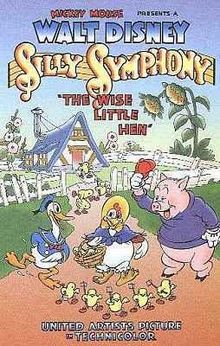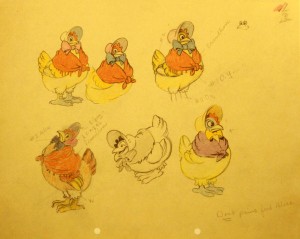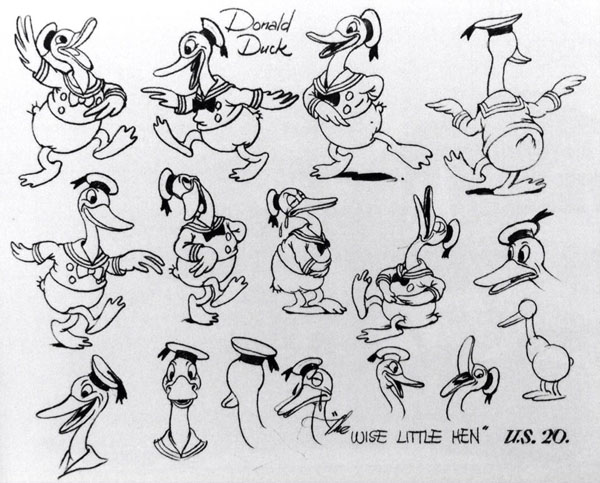
Tomorrow is Donald Duck’s birthday, so it’s only fitting to discuss his film debut!
 Based on the moralistic Russian folk tale, “The Little Red Hen and the Grain of Wheat,” the story outline for The Wise Little Hen circulated around November 1933. Besides the titular hen in the outline, the principal characters she asked for assistance in planting and harvesting corn were Peter Pig (slated to be the original star of the film) and Donald Duck. However, one other character, Tom Turkey, appeared in the original outline. Poor Tom was eliminated during the story development, which continued around December 1933 and January 1934. Albert Hurter designed the characters, including Donald Duck’s sailor cap and middy blouse. British actress Florence Gill provided the hen’s clucking and voice, while Clarence Nash performed the vocals for Peter Pig and Donald Duck.
Based on the moralistic Russian folk tale, “The Little Red Hen and the Grain of Wheat,” the story outline for The Wise Little Hen circulated around November 1933. Besides the titular hen in the outline, the principal characters she asked for assistance in planting and harvesting corn were Peter Pig (slated to be the original star of the film) and Donald Duck. However, one other character, Tom Turkey, appeared in the original outline. Poor Tom was eliminated during the story development, which continued around December 1933 and January 1934. Albert Hurter designed the characters, including Donald Duck’s sailor cap and middy blouse. British actress Florence Gill provided the hen’s clucking and voice, while Clarence Nash performed the vocals for Peter Pig and Donald Duck.
At a young age, Nash imitated various animal sounds for the amusement of his classmates, and recited “Mary Had a Little Lamb,” in the voice of a baby goat he received as a pet, for a talent show. The voice was sourced from the little goat’s cries of withdrawal whenever Nash stopped feeding it with a baby bottle. After he dropped out of school, Nash headed to the Midwest as a mandolin player and animal impersonator in different vaudeville circuits. After these venues dissolved in the mid-‘20s, Nash moved to California and found himself performing his animal sounds on the KHJ local radio show, The Merry Makers. The Adohr Milk Company heard his performance, and hired him as “Whistling Clarence, the Whistling Bird Man,” as Nash entertained children with bird calls and animal sounds while selling Adohr products.
While working for Adohr, as a favor to a friend in San Francisco, Nash performed a free broadcast of The Merry Makers, unaware that Walt Disney and his story team were listening during their meeting. After the urges of his friends, Nash auditioned at Disney’s studio for Wilfred Jackson, the director of Wise Little Hen. He performed his repertoire of animal imitations, bird calls and his recitation of “Mary Had a Little Lamb.” Disney was impressed with the latter part of his audition, and stated to Jackson that it would be perfect for a talking duck, even though Nash’s intentions were for a baby goat. Nash wasn’t hired at the studio just yet, and he performed bird sounds in various cartoons while working for Adohr.
 Coincidentally, around this period, Ub Iwerks’ studio was working on the second entry of the ComiColor series based on the tale, The Little Red Hen. Otto Englander, a former story artist for Disney, asked Nash to audition for the film. It was still in developmental stages, and not ready for recording; Nash became acquainted with the storyboard read off the dialogue from the script, with directors Shamus Culhane and Al Eugster present. He contacted Disney for permission about recording for Iwerks’ film, but he was unavailable. Disney phoned for Nash numerous times, but without an answer, since he was out at his regular Adohr job. He left a message for Nash, asking him not to participate in the film. After a story meeting of The Wise Little Hen, Disney and Nash negotiated an agreement for him to sign an exclusive contract. Nash ultimately turned down the Iwerks film, and was officially hired on the studio payroll on December 2, 1933. (Recent evidence, from a gag drawing, confirmed that animator Norm Blackburn later provided the hen’s voice in Iwerks’ version.)
Coincidentally, around this period, Ub Iwerks’ studio was working on the second entry of the ComiColor series based on the tale, The Little Red Hen. Otto Englander, a former story artist for Disney, asked Nash to audition for the film. It was still in developmental stages, and not ready for recording; Nash became acquainted with the storyboard read off the dialogue from the script, with directors Shamus Culhane and Al Eugster present. He contacted Disney for permission about recording for Iwerks’ film, but he was unavailable. Disney phoned for Nash numerous times, but without an answer, since he was out at his regular Adohr job. He left a message for Nash, asking him not to participate in the film. After a story meeting of The Wise Little Hen, Disney and Nash negotiated an agreement for him to sign an exclusive contract. Nash ultimately turned down the Iwerks film, and was officially hired on the studio payroll on December 2, 1933. (Recent evidence, from a gag drawing, confirmed that animator Norm Blackburn later provided the hen’s voice in Iwerks’ version.)
The principal animators in this film are mainly cast by sequence; Art Babbitt handles the introductory scenes of Peter Pig and Donald Duck, with Gerry Geronimi animating the hen, with her chicks, asking for assistance in planting and harvesting corn from the two. Louie Schmitt handles the sequences of the hen and chicks cultivating their corn. Gilles “Frenchy” de Tremaudan animates Peter Pig and Donald Duck’s second bout of bellyaches, before the hen discovers their ruse. Dick Huemer handles the entire finale, with remarkable draftsmanship that strikingly matches his earlier work for Max Fleischer on the Out of the Inkwell series. Though Wilfred Jackson directed Wise Little Hen, there are some junior animators, supervised by Ben Sharpsteen, credited in the draft. These artists include Archie Robin, Wolfgang Reitherman and effects animator Ugo D’Orsi, who primarily animated scenes containing corn, including the delectable sequences of the hen preparing her feast.
 Donald Duck in name first appeared in a 1931 storybook published by the David McKay Company, The Adventures of Mickey Mouse. The little duck only served as part of Mickey’s barnyard menagerie of friends, without much resemblance to the decipherable character that made his screen debut in The Wise Little Hen. This version of Donald later appeared in a story (“Mickey’s Hoozoo”) in the British Mickey Mouse Annual #3, published a year later.
Donald Duck in name first appeared in a 1931 storybook published by the David McKay Company, The Adventures of Mickey Mouse. The little duck only served as part of Mickey’s barnyard menagerie of friends, without much resemblance to the decipherable character that made his screen debut in The Wise Little Hen. This version of Donald later appeared in a story (“Mickey’s Hoozoo”) in the British Mickey Mouse Annual #3, published a year later.
The definitive Donald Duck had been announced in The Los Angeles Times by December 1933, when The Wise Little Hen was still in story development. However, his character/voice actually debuted on a radio broadcast—NBC’s Hind’s Hall of Fame, on March 4, 1934, three months before The Wise Little Hen’s release. In the show, host Mickey Mouse is constantly interrupted by Donald wanting to recite “Mary Had a Little Lamb” into the microphone. The Wise Little Hen doesn’t utilize these particular attributes, or even his famous temperament, of Donald’s personality; no longer surviving today, the broadcast indicates a trial run of interactions between Mickey and Donald in Orphan’s Benefit (1934) and The Band Concert (1935).
Near the end of the film, after Peter Pig gives a disgusting look at a bottle of castor oil given to him and Donald for their “bellyaches,” he gives off a look of thought. This moment cuts abruptly to the hen and her chicks enjoying their meal. As indicated on the draft, in between these two scenes, Peter hands Donald the castor oil in a gesture of faux-politeness, after which Donald repeats the action. Evidently, the film went through a revision after Technicolor photography had already finished. A silent Technicolor print survives of the original footage, along with alternate editing of different sequences, including Donald’s dance to “The Sailor’s Hornpipe,” which was intended to run longer than it does in the final edit. The draft doesn’t indicate Peter and Donald’s knowing looks to the audience after feigning their illnesses the first time, but these, presumably, might have been handled by the same animators.
Hope Donald’s birthday’s a good one tomorrow! Enjoy!
Click draft pages below to enlarge:


(Thanks to Mark Kausler, Dave Gerstein, J.B. Kaufman, Jim Korkis and Yowp for their help.)








 DEVON BAXTER is a film restoration artist, video editor, and animation researcher/writer currently residing in Pennsylvania. He also hosts a
DEVON BAXTER is a film restoration artist, video editor, and animation researcher/writer currently residing in Pennsylvania. He also hosts a 





















































































Fun Fact: Donald Duck is the only Disney character who is the mascot for the University of Oregon. The U of O used Donald’s likeness for thier mascot and Walt approved the use of Donald Duck as the mascot for the University of Oregon. The mascot’s name is Puddles aka The Duck but he’s the doppelgänger of Donald Duck every time when you see his image the copyright for Disney (either as Disney or WDP (Walt Disney Productions) in the older images show that he’s still the property of Disney.
Amazing! The original Donald wore pants!
The more you know! I suppose it was the right decision to ditch the pants very quickly.
Even today, there is a refreshing simplicity and charm about this cartoon. It holds up very well. This is a beautiful print. The colors are rich and vibrant. It looks like it could have been made recently instead of a long time ago. And its message is of course timeless.
The comic strip version of “Wise Little Hen” was recently reprinted in “Silly Symphonies Volume One” from IDW.
Happy Birthday to Donald Duck! “Who’s got the sweetest disposition?”
Happy Birthday Donald!
I’ve got one of his cartoons (complete with RKO titles) on 16mm Blue Track IB Tech!
I still have the old comic strip version from Walt Disney Animated Features and Silly Symphonies (The comic starts at September 16 and ends on December 16 in the same year, 1934, months later after the release).
You should have done something a few weeks ago for the Goof’s birthday!
I have both,the film ,in 8 mm and the book!
As a kid, that cut between Peter Pig discovering the Castor Oil bottle and showing the Hen eating with her family always came off odd to me the way the music simply kicks in and it looked like Peter Pig was about to say something just as the scene shift over to the dinner table. Checking the drafts, I guess there was a couple shots that were either finished or unfinished and they simply left it in as-is here, but it used to peeve me as a kid to notice how jarring that was.